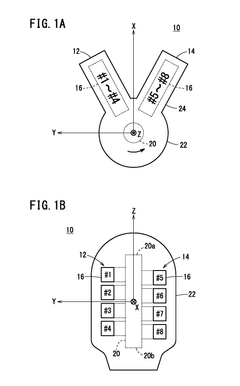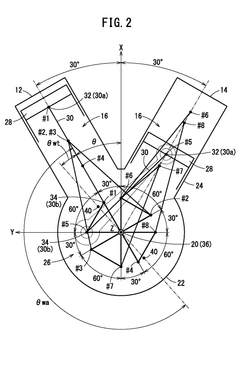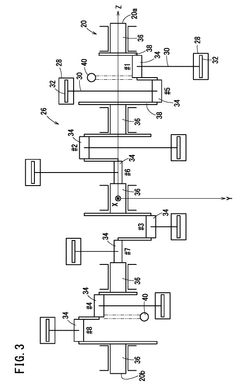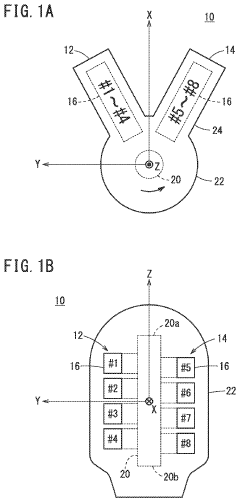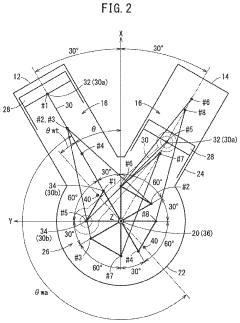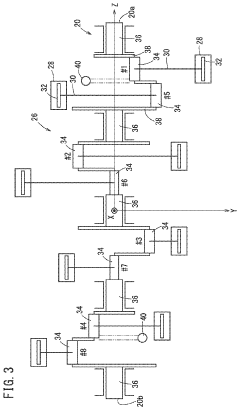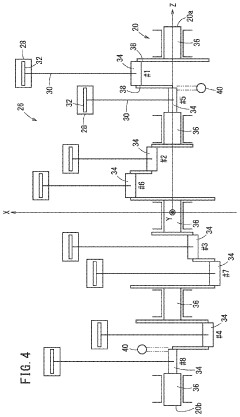Understanding V8 Engine Mechanics: A Comprehensive Guide
JUL 4, 20259 MIN READ
Generate Your Research Report Instantly with AI Agent
Patsnap Eureka helps you evaluate technical feasibility & market potential.
V8 Engine Evolution and Objectives
The V8 engine, a revolutionary powerplant that has shaped the automotive industry for over a century, has undergone significant evolution since its inception. Originally developed by Cadillac in 1914, this engine configuration quickly gained popularity due to its compact design and impressive power output. The V8's journey from its early days to modern high-performance applications showcases a remarkable progression in engineering and technology.
In the early stages, V8 engines were primarily focused on increasing displacement and power output. However, as environmental concerns and fuel efficiency became paramount, the objectives shifted towards optimizing performance while reducing emissions and fuel consumption. This paradigm shift led to the development of advanced technologies such as variable valve timing, direct fuel injection, and cylinder deactivation.
The evolution of V8 engines can be traced through several key milestones. The introduction of overhead valve designs in the 1940s marked a significant improvement in efficiency and power. The 1960s and 1970s saw the rise of high-performance muscle car engines, pushing the boundaries of horsepower and torque. The 1980s and 1990s brought fuel injection systems and computer-controlled engine management, enhancing both performance and efficiency.
In recent years, the focus has shifted towards sustainability and electrification. Many manufacturers are now developing hybrid V8 systems, combining traditional internal combustion with electric motors to achieve both power and efficiency. Additionally, advancements in materials science have allowed for lighter, stronger engine components, further improving performance and fuel economy.
The current objectives for V8 engine development are multifaceted. Engineers are striving to maintain the characteristic power and sound that enthusiasts love while meeting increasingly stringent emissions regulations. This involves pushing the boundaries of thermal efficiency, exploring new combustion techniques, and integrating cutting-edge electronic control systems.
Another key objective is the adaptation of V8 engines to alternative fuels, such as hydrogen and synthetic fuels, to reduce their carbon footprint. Manufacturers are also investing in advanced manufacturing techniques, like 3D printing, to create more complex and efficient engine designs that were previously impossible to produce.
As we look to the future, the V8 engine faces both challenges and opportunities. While some predict its eventual phase-out in favor of fully electric powertrains, others see potential in its continued evolution. The ongoing development of V8 engines serves as a testament to human ingenuity and the relentless pursuit of automotive excellence, balancing performance, efficiency, and environmental responsibility.
In the early stages, V8 engines were primarily focused on increasing displacement and power output. However, as environmental concerns and fuel efficiency became paramount, the objectives shifted towards optimizing performance while reducing emissions and fuel consumption. This paradigm shift led to the development of advanced technologies such as variable valve timing, direct fuel injection, and cylinder deactivation.
The evolution of V8 engines can be traced through several key milestones. The introduction of overhead valve designs in the 1940s marked a significant improvement in efficiency and power. The 1960s and 1970s saw the rise of high-performance muscle car engines, pushing the boundaries of horsepower and torque. The 1980s and 1990s brought fuel injection systems and computer-controlled engine management, enhancing both performance and efficiency.
In recent years, the focus has shifted towards sustainability and electrification. Many manufacturers are now developing hybrid V8 systems, combining traditional internal combustion with electric motors to achieve both power and efficiency. Additionally, advancements in materials science have allowed for lighter, stronger engine components, further improving performance and fuel economy.
The current objectives for V8 engine development are multifaceted. Engineers are striving to maintain the characteristic power and sound that enthusiasts love while meeting increasingly stringent emissions regulations. This involves pushing the boundaries of thermal efficiency, exploring new combustion techniques, and integrating cutting-edge electronic control systems.
Another key objective is the adaptation of V8 engines to alternative fuels, such as hydrogen and synthetic fuels, to reduce their carbon footprint. Manufacturers are also investing in advanced manufacturing techniques, like 3D printing, to create more complex and efficient engine designs that were previously impossible to produce.
As we look to the future, the V8 engine faces both challenges and opportunities. While some predict its eventual phase-out in favor of fully electric powertrains, others see potential in its continued evolution. The ongoing development of V8 engines serves as a testament to human ingenuity and the relentless pursuit of automotive excellence, balancing performance, efficiency, and environmental responsibility.
Market Demand for High-Performance JavaScript Engines
The demand for high-performance JavaScript engines has grown exponentially in recent years, driven by the increasing complexity of web applications and the expanding role of JavaScript in server-side and mobile development. As web applications become more sophisticated, handling tasks from simple data manipulation to complex real-time operations, the need for efficient JavaScript execution has become paramount.
In the browser market, major players like Google Chrome, Mozilla Firefox, and Apple Safari are in constant competition to offer the fastest and most efficient JavaScript engines. This competition has led to significant improvements in JavaScript performance, with each new browser version touting better execution speeds and lower memory consumption. The V8 engine, developed by Google for Chrome and Node.js, has been at the forefront of this performance race, setting benchmarks for other engines to follow.
The rise of server-side JavaScript, particularly through Node.js, has created a new market segment demanding high-performance JavaScript engines. Companies building large-scale, real-time applications and microservices architectures are increasingly turning to Node.js for its speed and scalability. This trend has further intensified the need for JavaScript engines that can handle heavy computational loads efficiently.
Mobile app development has also contributed to the growing demand for optimized JavaScript engines. Frameworks like React Native and Ionic, which allow developers to build cross-platform mobile apps using JavaScript, rely heavily on the performance of underlying JavaScript engines to deliver native-like user experiences.
The Internet of Things (IoT) sector represents another emerging market for high-performance JavaScript engines. As IoT devices become more powerful and capable of running complex applications, JavaScript's versatility makes it an attractive option for developers. However, the resource constraints of many IoT devices necessitate highly efficient JavaScript execution.
Cloud computing providers have also recognized the importance of JavaScript performance. Many cloud platforms now offer optimized JavaScript runtimes as part of their serverless computing offerings, allowing developers to run JavaScript functions with minimal overhead and maximum efficiency.
The financial technology sector, with its need for real-time data processing and complex calculations, has become another significant driver of demand for high-performance JavaScript engines. Trading platforms and financial analysis tools increasingly rely on JavaScript for both front-end and back-end operations, requiring engines that can handle computationally intensive tasks with low latency.
In the browser market, major players like Google Chrome, Mozilla Firefox, and Apple Safari are in constant competition to offer the fastest and most efficient JavaScript engines. This competition has led to significant improvements in JavaScript performance, with each new browser version touting better execution speeds and lower memory consumption. The V8 engine, developed by Google for Chrome and Node.js, has been at the forefront of this performance race, setting benchmarks for other engines to follow.
The rise of server-side JavaScript, particularly through Node.js, has created a new market segment demanding high-performance JavaScript engines. Companies building large-scale, real-time applications and microservices architectures are increasingly turning to Node.js for its speed and scalability. This trend has further intensified the need for JavaScript engines that can handle heavy computational loads efficiently.
Mobile app development has also contributed to the growing demand for optimized JavaScript engines. Frameworks like React Native and Ionic, which allow developers to build cross-platform mobile apps using JavaScript, rely heavily on the performance of underlying JavaScript engines to deliver native-like user experiences.
The Internet of Things (IoT) sector represents another emerging market for high-performance JavaScript engines. As IoT devices become more powerful and capable of running complex applications, JavaScript's versatility makes it an attractive option for developers. However, the resource constraints of many IoT devices necessitate highly efficient JavaScript execution.
Cloud computing providers have also recognized the importance of JavaScript performance. Many cloud platforms now offer optimized JavaScript runtimes as part of their serverless computing offerings, allowing developers to run JavaScript functions with minimal overhead and maximum efficiency.
The financial technology sector, with its need for real-time data processing and complex calculations, has become another significant driver of demand for high-performance JavaScript engines. Trading platforms and financial analysis tools increasingly rely on JavaScript for both front-end and back-end operations, requiring engines that can handle computationally intensive tasks with low latency.
V8 Architecture and Technical Challenges
V8's architecture is a complex system designed to efficiently execute JavaScript code. At its core, V8 employs a multi-tiered compilation strategy, which includes an interpreter and two levels of Just-In-Time (JIT) compilers. This approach allows V8 to balance between quick startup times and optimal performance for long-running applications.
The interpreter, known as Ignition, is responsible for executing bytecode quickly. It serves as the first line of execution, allowing for rapid startup and providing profiling information for subsequent optimization stages. Ignition's design focuses on memory efficiency and quick interpretation of JavaScript code.
TurboFan, V8's optimizing compiler, represents the next tier in the compilation process. It takes frequently executed code identified by the interpreter and applies advanced optimization techniques. TurboFan utilizes a sea-of-nodes intermediate representation, allowing for sophisticated optimizations such as inlining, loop invariant code motion, and dead code elimination.
One of the primary technical challenges in V8's architecture is managing the trade-off between compilation time and execution speed. The engine must decide when to invest time in optimizing code and when to rely on interpreted execution. This decision-making process is crucial for maintaining both responsiveness and long-term performance.
Another significant challenge is handling JavaScript's dynamic nature. V8 employs speculative optimizations based on observed types and behaviors. However, when these assumptions are violated, the engine must quickly de-optimize and fall back to less optimized code. This process, known as deoptimization, is a complex and performance-critical component of V8's architecture.
Memory management presents another set of challenges. V8 implements a generational garbage collector to efficiently handle object allocation and deallocation. The collector must balance throughput, latency, and memory usage, adapting to various workloads and memory constraints across different devices and platforms.
V8's architecture also faces challenges in supporting new JavaScript features and optimizing for emerging use cases. As the language evolves, the engine must efficiently implement new syntax and semantics while maintaining backwards compatibility. This requires careful design considerations and often leads to architectural changes to accommodate new language features effectively.
Lastly, V8 must address the challenge of cross-platform compatibility. As it powers JavaScript execution in various environments, from browsers to server-side applications, V8's architecture needs to be flexible enough to adapt to different hardware and operating system constraints while maintaining consistent performance characteristics.
The interpreter, known as Ignition, is responsible for executing bytecode quickly. It serves as the first line of execution, allowing for rapid startup and providing profiling information for subsequent optimization stages. Ignition's design focuses on memory efficiency and quick interpretation of JavaScript code.
TurboFan, V8's optimizing compiler, represents the next tier in the compilation process. It takes frequently executed code identified by the interpreter and applies advanced optimization techniques. TurboFan utilizes a sea-of-nodes intermediate representation, allowing for sophisticated optimizations such as inlining, loop invariant code motion, and dead code elimination.
One of the primary technical challenges in V8's architecture is managing the trade-off between compilation time and execution speed. The engine must decide when to invest time in optimizing code and when to rely on interpreted execution. This decision-making process is crucial for maintaining both responsiveness and long-term performance.
Another significant challenge is handling JavaScript's dynamic nature. V8 employs speculative optimizations based on observed types and behaviors. However, when these assumptions are violated, the engine must quickly de-optimize and fall back to less optimized code. This process, known as deoptimization, is a complex and performance-critical component of V8's architecture.
Memory management presents another set of challenges. V8 implements a generational garbage collector to efficiently handle object allocation and deallocation. The collector must balance throughput, latency, and memory usage, adapting to various workloads and memory constraints across different devices and platforms.
V8's architecture also faces challenges in supporting new JavaScript features and optimizing for emerging use cases. As the language evolves, the engine must efficiently implement new syntax and semantics while maintaining backwards compatibility. This requires careful design considerations and often leads to architectural changes to accommodate new language features effectively.
Lastly, V8 must address the challenge of cross-platform compatibility. As it powers JavaScript execution in various environments, from browsers to server-side applications, V8's architecture needs to be flexible enough to adapt to different hardware and operating system constraints while maintaining consistent performance characteristics.
Current V8 Optimization Techniques
01 V8 Engine Design and Configuration
V8 engines are designed with eight cylinders arranged in two banks of four, forming a V-shape. This configuration allows for compact packaging, improved balance, and higher power output. The design includes considerations for cylinder block layout, crankshaft arrangement, and valve train systems to optimize performance and efficiency.- V8 Engine Design and Configuration: V8 engines are characterized by their V-shaped cylinder arrangement, typically with four cylinders on each bank. This design offers a balance between power output and compact size, making it popular in high-performance vehicles and trucks. The configuration allows for efficient packaging and improved weight distribution, contributing to better vehicle handling and performance.
- Valve Train and Camshaft Systems: Advanced valve train systems in V8 engines often incorporate variable valve timing and lift technologies to optimize engine performance across different operating conditions. These systems may include dual overhead camshafts (DOHC) or pushrod designs with roller lifters to reduce friction and improve efficiency. Innovations in camshaft design and actuation contribute to enhanced power output and fuel economy.
- Fuel Injection and Combustion Optimization: Modern V8 engines utilize sophisticated fuel injection systems, including direct injection technology, to improve fuel atomization and combustion efficiency. Advanced engine management systems control fuel delivery and ignition timing to optimize performance and emissions. Innovations in combustion chamber design and piston geometry further enhance the engine's power output and thermal efficiency.
- Forced Induction and Power Enhancement: Many high-performance V8 engines incorporate forced induction systems such as turbochargers or superchargers to increase power output. These systems compress the intake air, allowing for more fuel to be burned and generating higher power levels. Advanced intercooling and charge air management techniques are often employed to maximize the efficiency of forced induction systems in V8 engines.
- Engine Monitoring and Diagnostics: V8 engines often feature advanced monitoring and diagnostic systems to ensure optimal performance and reliability. These may include sensors for temperature, pressure, and exhaust composition, as well as sophisticated engine control units (ECUs) that continuously adjust engine parameters. Some systems incorporate predictive maintenance capabilities and real-time performance optimization algorithms.
02 Fuel Injection and Combustion Systems
Advanced fuel injection and combustion systems are crucial for V8 engine performance. These systems include direct injection technology, variable valve timing, and precise fuel metering to enhance power output, fuel efficiency, and emissions control. Innovations in this area focus on optimizing the air-fuel mixture and combustion process.Expand Specific Solutions03 Engine Cooling and Lubrication
Effective cooling and lubrication systems are essential for V8 engine reliability and longevity. These systems manage heat dissipation, reduce friction, and ensure proper component protection. Innovations include advanced coolant circulation methods, oil pump designs, and thermal management strategies to maintain optimal operating temperatures.Expand Specific Solutions04 Performance Monitoring and Diagnostics
Modern V8 engines incorporate sophisticated monitoring and diagnostic systems. These include sensors, electronic control units, and data analysis tools to track engine performance, detect potential issues, and optimize operating parameters in real-time. Advanced diagnostics help in predictive maintenance and troubleshooting.Expand Specific Solutions05 Emissions Control and Efficiency Improvements
V8 engine mechanics focus on reducing emissions and improving overall efficiency. This includes the development of advanced exhaust gas recirculation systems, catalytic converters, and variable displacement technologies. These innovations aim to meet stringent environmental regulations while maintaining high performance levels.Expand Specific Solutions
Key Players in JavaScript Engine Development
The V8 engine market is in a mature stage, characterized by established players and incremental innovations. The global market size for V8 engines is substantial, driven by demand in high-performance vehicles and luxury segments. Technologically, V8 engines have reached a high level of sophistication, with companies like Honda, Toyota, BMW, and Ford leading in refinements. These manufacturers are focusing on improving efficiency, reducing emissions, and integrating hybrid technologies to meet stringent environmental regulations. The competitive landscape is intense, with traditional automotive giants competing alongside specialized engine manufacturers, each striving to balance performance with fuel economy and environmental considerations.
Honda Motor Co., Ltd.
Technical Solution: While Honda is not primarily known for V8 engines, they have developed notable V8 technologies, particularly for racing applications. Their IndyCar V8 engine features a compact design with a 90-degree V-angle, direct fuel injection, and advanced materials for weight reduction[10]. In production vehicles, Honda has focused on V6 engines but has applied technologies that could be relevant to V8 development, such as their i-VTEC (intelligent Variable Valve Timing and Lift Electronic Control) system and Earth Dreams Technology for improved efficiency[11].
Strengths: Racing-derived technologies, focus on efficiency and compact design. Weaknesses: Limited experience with production V8 engines, potential challenges in scaling racing technologies to mass production.
Toyota Motor Corp.
Technical Solution: Toyota's approach to V8 engine technology emphasizes reliability and efficiency. Their UR series V8 engines feature aluminum block construction, dual overhead camshafts, and Dual VVT-i (Variable Valve Timing with intelligence) for optimized performance across various operating conditions[7]. Toyota has also developed D-4S direct and port fuel injection systems for their V8 engines, which improve fuel efficiency and reduce emissions[8]. In some markets, Toyota offers hybrid V8 powertrains, combining traditional V8 power with electric motors for improved efficiency[9].
Strengths: Renowned reliability, efficient fuel injection systems, hybrid integration. Weaknesses: May lag behind competitors in outright performance metrics, slower adoption of some advanced technologies.
Core Innovations in V8 Engine Design
V8 engine
PatentWO2021171405A1
Innovation
- The engine is configured with a 60° bank angle, where crank pins on one bank are arranged at 90° intervals and offset by 60° from the other bank, allowing for cancellation of the primary inertia couple without additional special parts, and the ignition timing is set to achieve balanced explosions similar to conventional V8 engines.
V8 engine
PatentActiveUS20230109196A1
Innovation
- The V8 engine configuration features crank pins arranged at 90° intervals on one bank and offset by 60° on the other bank, allowing for cancellation of primary inertia couples without additional specialized components by optimizing the arrangement of crank pins and connecting rods.
V8 Engine Benchmarking and Performance Metrics
Benchmarking and performance metrics play a crucial role in understanding and optimizing the V8 engine's capabilities. These metrics provide valuable insights into the engine's efficiency, speed, and overall performance across various scenarios. One of the primary benchmarking tools used for V8 is the Octane benchmark suite, which consists of a set of JavaScript tests designed to measure different aspects of JavaScript execution.
The Octane benchmark suite includes tests that evaluate the engine's performance in areas such as function and method calls, arithmetic and bitwise operations, array manipulations, and object-oriented programming. These tests are designed to simulate real-world JavaScript applications and provide a comprehensive assessment of the engine's capabilities.
Another important benchmark for V8 is the JetStream benchmark suite, which focuses on advanced web applications. JetStream includes a variety of JavaScript and WebAssembly benchmarks, testing areas such as parsing, compilation, execution, and garbage collection. This suite provides a more holistic view of the engine's performance in modern web environments.
Performance metrics for V8 often include execution time, memory usage, and garbage collection efficiency. Execution time is typically measured in milliseconds and is a key indicator of the engine's speed and optimization capabilities. Memory usage metrics help developers understand how efficiently V8 manages memory allocation and deallocation, which is crucial for long-running applications.
Garbage collection metrics are particularly important for V8, as efficient memory management is critical for maintaining smooth performance in JavaScript applications. These metrics include the frequency of garbage collection cycles, the duration of each cycle, and the amount of memory reclaimed during collection.
V8 also provides built-in profiling tools that allow developers to analyze the performance of their JavaScript code. These tools, such as the V8 CPU Profiler and Heap Profiler, offer detailed insights into function call times, memory allocation patterns, and potential bottlenecks in the code.
Comparative benchmarking against other JavaScript engines, such as SpiderMonkey and JavaScriptCore, is often performed to assess V8's relative performance. These comparisons help identify areas where V8 excels and areas that may require further optimization.
It's important to note that while benchmarks provide valuable data, they should be interpreted cautiously. Real-world performance can vary significantly depending on the specific use case and application architecture. Therefore, a combination of standardized benchmarks and application-specific performance testing is often necessary to gain a comprehensive understanding of V8's performance in practice.
The Octane benchmark suite includes tests that evaluate the engine's performance in areas such as function and method calls, arithmetic and bitwise operations, array manipulations, and object-oriented programming. These tests are designed to simulate real-world JavaScript applications and provide a comprehensive assessment of the engine's capabilities.
Another important benchmark for V8 is the JetStream benchmark suite, which focuses on advanced web applications. JetStream includes a variety of JavaScript and WebAssembly benchmarks, testing areas such as parsing, compilation, execution, and garbage collection. This suite provides a more holistic view of the engine's performance in modern web environments.
Performance metrics for V8 often include execution time, memory usage, and garbage collection efficiency. Execution time is typically measured in milliseconds and is a key indicator of the engine's speed and optimization capabilities. Memory usage metrics help developers understand how efficiently V8 manages memory allocation and deallocation, which is crucial for long-running applications.
Garbage collection metrics are particularly important for V8, as efficient memory management is critical for maintaining smooth performance in JavaScript applications. These metrics include the frequency of garbage collection cycles, the duration of each cycle, and the amount of memory reclaimed during collection.
V8 also provides built-in profiling tools that allow developers to analyze the performance of their JavaScript code. These tools, such as the V8 CPU Profiler and Heap Profiler, offer detailed insights into function call times, memory allocation patterns, and potential bottlenecks in the code.
Comparative benchmarking against other JavaScript engines, such as SpiderMonkey and JavaScriptCore, is often performed to assess V8's relative performance. These comparisons help identify areas where V8 excels and areas that may require further optimization.
It's important to note that while benchmarks provide valuable data, they should be interpreted cautiously. Real-world performance can vary significantly depending on the specific use case and application architecture. Therefore, a combination of standardized benchmarks and application-specific performance testing is often necessary to gain a comprehensive understanding of V8's performance in practice.
V8 Integration with Web Browsers and Node.js
V8's integration with web browsers and Node.js represents a crucial aspect of its widespread adoption and impact on modern web development. In the context of web browsers, V8 serves as the JavaScript engine powering popular browsers like Google Chrome and Microsoft Edge. This integration allows for efficient execution of JavaScript code within web pages, enabling dynamic and interactive user experiences.
The integration process involves several key components. Firstly, V8 is embedded within the browser's architecture, typically as a separate module or library. This modular approach allows for easier maintenance and updates to the engine without affecting other browser components. The browser's rendering engine communicates with V8 through well-defined APIs, passing JavaScript code for execution and receiving the results.
V8's integration with web browsers also includes optimizations specific to web environments. For instance, it implements efficient garbage collection mechanisms to manage memory usage in long-running web applications. Additionally, V8 provides features like just-in-time (JIT) compilation and inline caching, which significantly enhance JavaScript performance in browser contexts.
In the realm of Node.js, V8 plays an equally vital role. Node.js, a server-side JavaScript runtime, utilizes V8 as its core JavaScript engine. This integration enables developers to use JavaScript for both client-side and server-side programming, promoting code reuse and consistency across the full stack.
The integration of V8 with Node.js involves adapting the engine to work in a non-browser environment. This includes implementing APIs for file system access, network operations, and other server-side functionalities. Node.js wraps V8 with additional modules and libraries, providing a comprehensive platform for building scalable network applications.
One of the key benefits of V8's integration with Node.js is the ability to leverage V8's performance optimizations in server-side applications. This includes features like the Crankshaft and TurboFan optimizing compilers, which significantly boost the execution speed of JavaScript code.
Furthermore, the integration allows for consistent JavaScript behavior across different environments. Developers can rely on the same JavaScript features and optimizations whether they're working in a browser or a Node.js environment, reducing the learning curve and improving productivity.
The ongoing development of V8 continues to influence both web browsers and Node.js. New features and optimizations introduced in V8 are regularly incorporated into these platforms, ensuring that developers have access to the latest JavaScript capabilities and performance improvements.
The integration process involves several key components. Firstly, V8 is embedded within the browser's architecture, typically as a separate module or library. This modular approach allows for easier maintenance and updates to the engine without affecting other browser components. The browser's rendering engine communicates with V8 through well-defined APIs, passing JavaScript code for execution and receiving the results.
V8's integration with web browsers also includes optimizations specific to web environments. For instance, it implements efficient garbage collection mechanisms to manage memory usage in long-running web applications. Additionally, V8 provides features like just-in-time (JIT) compilation and inline caching, which significantly enhance JavaScript performance in browser contexts.
In the realm of Node.js, V8 plays an equally vital role. Node.js, a server-side JavaScript runtime, utilizes V8 as its core JavaScript engine. This integration enables developers to use JavaScript for both client-side and server-side programming, promoting code reuse and consistency across the full stack.
The integration of V8 with Node.js involves adapting the engine to work in a non-browser environment. This includes implementing APIs for file system access, network operations, and other server-side functionalities. Node.js wraps V8 with additional modules and libraries, providing a comprehensive platform for building scalable network applications.
One of the key benefits of V8's integration with Node.js is the ability to leverage V8's performance optimizations in server-side applications. This includes features like the Crankshaft and TurboFan optimizing compilers, which significantly boost the execution speed of JavaScript code.
Furthermore, the integration allows for consistent JavaScript behavior across different environments. Developers can rely on the same JavaScript features and optimizations whether they're working in a browser or a Node.js environment, reducing the learning curve and improving productivity.
The ongoing development of V8 continues to influence both web browsers and Node.js. New features and optimizations introduced in V8 are regularly incorporated into these platforms, ensuring that developers have access to the latest JavaScript capabilities and performance improvements.
Unlock deeper insights with Patsnap Eureka Quick Research — get a full tech report to explore trends and direct your research. Try now!
Generate Your Research Report Instantly with AI Agent
Supercharge your innovation with Patsnap Eureka AI Agent Platform!

